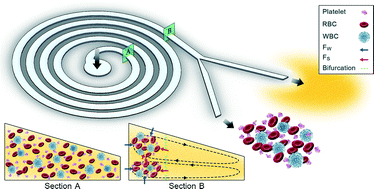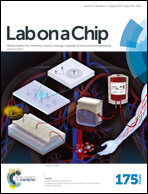Multiplexing slanted spiral microchannels for ultra-fast blood plasma separation†
Abstract
Blood and blood products are critical components of health care. Blood components perform distinct functions in the human body and thus the ability to efficiently fractionate blood into its individual components (i.e., plasma and cellular components) is of utmost importance for therapeutic and diagnostic purposes. Although conventional approaches like centrifugation and membrane filtration for blood processing have been successful in generating relatively pure fractions, they are largely limited by factors such as the required blood sample volume, component purity, clogging, processing time and operation efficiency. In this work, we developed a high-throughput inertial microfluidic system for cell focusing and blood plasma separation from small to large volume blood samples (1–100 mL). Initially, polystyrene beads and blood cells were used to investigate the inertial focusing performance of a single slanted spiral microchannel as a function of particle size, flow rate, and blood cell concentration. Afterwards, blood plasma separation was conducted using an optimised spiral microchannel with relatively large dimensions. It was found that the reject ratio of the slanted spiral channel is close to 100% for blood samples with haematocrit (HCT) values of 0.5% and 1% under an optimal flow rate of 1.5 mL min−1. Finally, through a unique multiplexing approach, we built a high-throughput system consisting of 16 spiral channels connected together, which can process diluted samples with a total flow rate as high as 24 mL min−1. The proposed multiplexed system can surmount the shortcomings of previously reported microfluidic systems for plasma separation and cell sorting in terms of throughput, yield and operation efficiency.


 Please wait while we load your content...
Please wait while we load your content...